Design Constraint Yields New Global Event
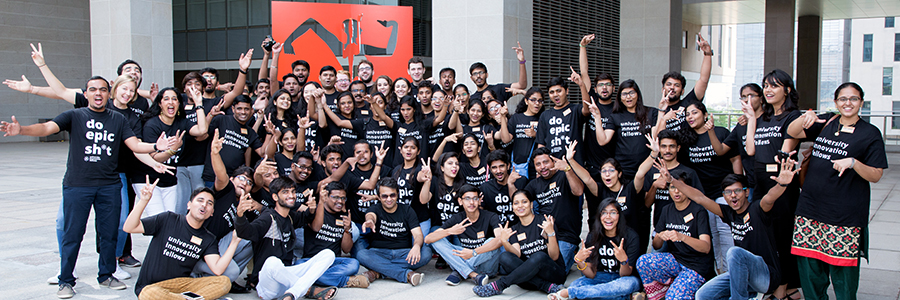
By Katie Dzugan
When we hold the Silicon Valley Meetup in California every year, we invite a huge number of people: 250+ Fellows, 24 FABs (UIF leaders/support), 20-30 faculty champions, speakers, special guests and more. Due to space constraints at the d.school and at Google, we’re limited to 300 people. Fitting all of these people in one building for an event has been one of our biggest design constraints in the program.
Then, in the last year and a half, we began to have a surge of interest in the program from schools in India. Thanks to funding from Google, since Fall 2016, we’ve welcomed 226 students from 40 institutions in India. With the addition of this amazing community (the largest global population of Fellows), we quickly began to far exceed our capacity at Silicon Valley Meetup. The cost and requirements of traveling from India to California were also proving challenging for many of the students.
This design constraint encouraged our team to get creative in hosting this event. It led us to develop a hypothesis — let’s bring the Meetup to the other side of the globe!
We tested this with the first ever Eastern Hemisphere Meetup in Bengaluru, India, on May 4-6, 2018. 55 Fellows from India and Australia joined us for the in-person, 3-day event.
The purpose of the Meetup is to solidify the mission of the students who are passionate about changing higher education and creating learning opportunities for their peers. This event connects Fellows with change agents across the globe – to see these people; to meet them; to learn from them. It strengthens their confidence that they are the dreamers and doers who can make a difference in the world. Gathering in person confirms the network of support that they access online throughout the year and creates a whole new level of relationship with the Fellows in attendance.
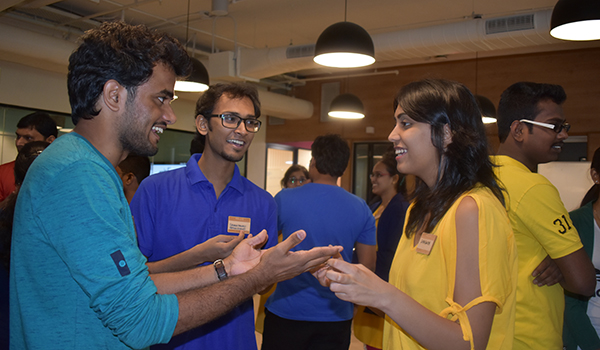
Fellows take part in a team building activity during the Eastern Hemisphere Meetup.
To accomplish this in India, we made plans to hold the event at CoWrks in Bengaluru, the largest co-working space in Southeast Asia, and at Google India. These two spaces, plus the people who run them, were our first of many affirmations that replicating the Meetup would work because the people and spaces, much like the d.school, exist in all areas of our world. You just need to find them.
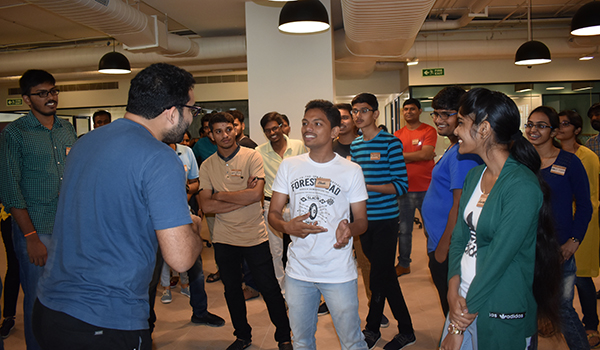
Fellows share their reactions to an activity at the beginning of the event.
We built the first evening, on May 4, around creating social relationships and connections. Even when all participants are attending the same event and are part of the same program, it does not mean each person is there for the same reason. We opened up the evening with progressive introductions for the Fellows, faculty, and team members who were registered. This introduction method is a rapid way to get participants mingling with everyone in the room. We then moved on to team-building, which to us means that we split up into four groups and created a team dance.
The following days included sessions about different approaches to thinking and how to utilize them; using space as a learning tool to enhance learning environments; teaching design thinking to others in teams or small groups; and a series of ignite talks from FABs.
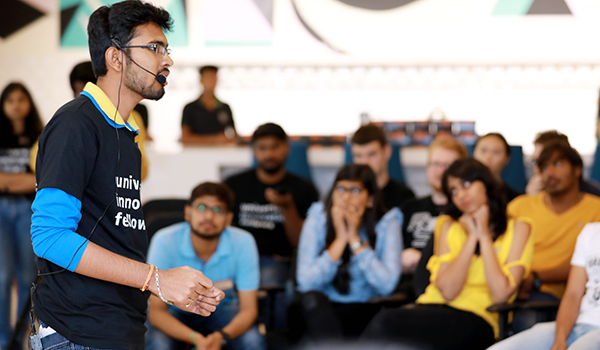
Fabs, experienced Fellows who helped run the event, gave talks to attendees.
“We take great care in making activities and examples relevant to Fellows — and their countries — through the challenges and examples we propose,” said Leticia Britos Cavagnaro, co-director of the UIF program, about the design of the overall event. “We really talk to the students about the issues they are facing; we read and listen to the news, and really pay attention to what is going on in the world around these students. It’s not about copying the Silicon Valley Meetup; it’s about making it unique to the students in India.”
The three days were also designed to incorporate topics from the UIF online training — storytelling, design thinking, and more — in order for students to engage with the information in a new way, through an in-person facilitator. The participants also explored leadership through movement, participated in design challenges that represent issues across India, and listened to speakers who are experts in industry.
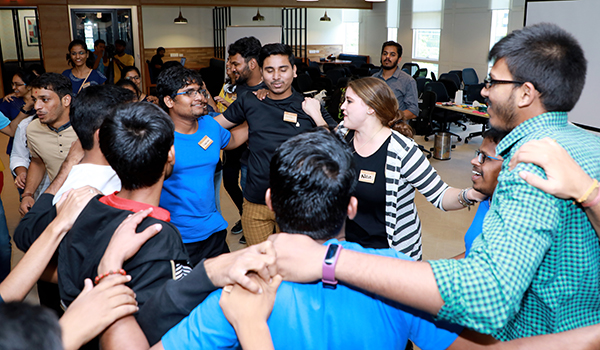
Fellows participate in a movement workshop.
By balancing design challenges, mini-sessions, and more, participants were able to discover new ways of learning. We also created an atmosphere for them to share their feelings, learnings and emotions. This helped them dig deep into learning experiences so they could design “sneaky lil’ experiments” to be implemented back at their schools.
Over the three intensive days, there were lots of discussions about how to support women in tech and engineering; how youth in India can have a greater impact; how to encourage students to be more creative and opportunistic; and how to help students think of themselves as the driving force for a new economy, one full of new industry, technology and startups.
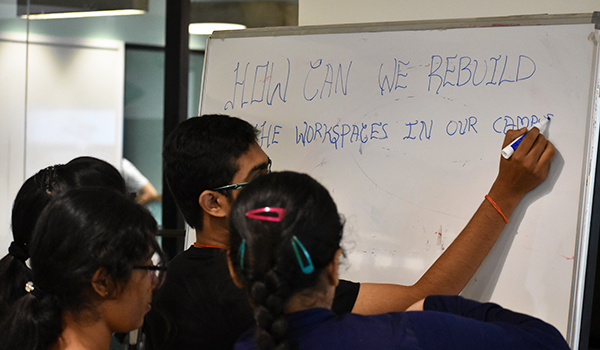
Participants work on a challenge during the event.
The Fellows in attendance were hungry to learn. Some even traveled 39 hours by train to join us! Their passion was palpable as they worked to figure out ways to solve challenges at their schools and in the world. From our team’s perspective, it was exciting to work with the Fellows and faculty in-person; to watch them engage in the way we deliver a learning experience and understand how they can teach other students and faculty at their own schools in a similar way.
This event wasn’t only for the students. The Meetup also invites faculty champions to step into the shoes of the learner. It is our intention to have both the student and faculty perspective readily available throughout the event because it takes a partnership to create the long-lasting, deep-rooted institutional change that we’re seeking.
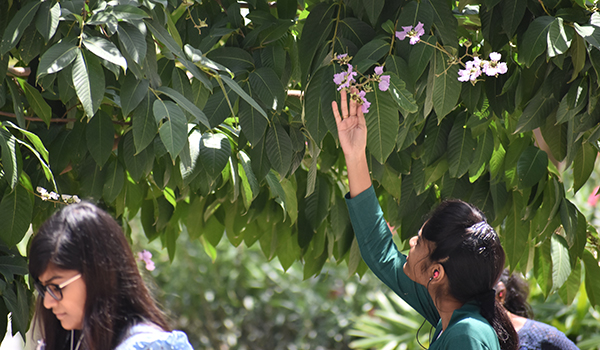
One activity focused on helping Fellows enhance their observation skills.
“It’s important for students to understand that it’s also hard for faculty to influence change on campus,” said Humera Fasihuddin, Co-Director of the UIF program. “Having faculty voices in the room helps students understand that this movement isn’t just about students asking for things or advocating for change. For faculty, it’s about truly listening to the appetite for change on campus through the student voice. Having that two way dialogue is really important here because it builds trust and develops those partnerships between students and faculty.”
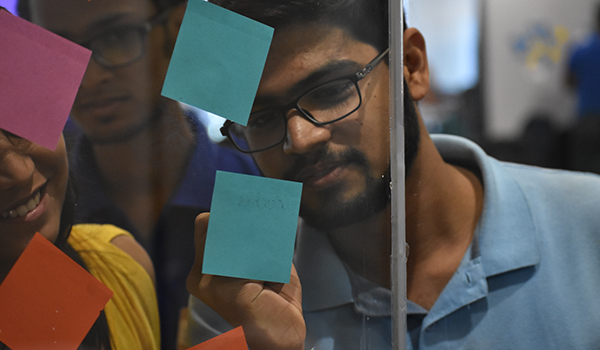
Fellows brainstorm during an activity.
From a stressful design constraint came an event that benefitted not only the students and faculty in attendance, but our team as well. We learned that we are able to transport the learning experience, energy, team and connections with industry to the other side of the world.
It’s thrilling to see the economy changing for a new workforce, and we are excited to support the next generation of learners. We eagerly look forward to hosting the second annual Eastern Hemisphere Meetup!
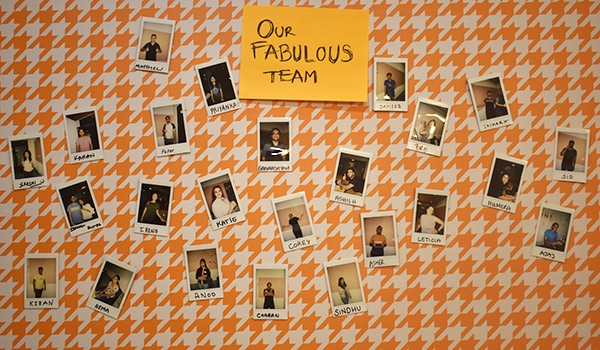
Event organizers included UIF team members, guest facilitators and Fellows.
Photos by Avinash Daniel Films and Siddhartha Mondreti





Leave a Reply
Want to join the discussion?Feel free to contribute!